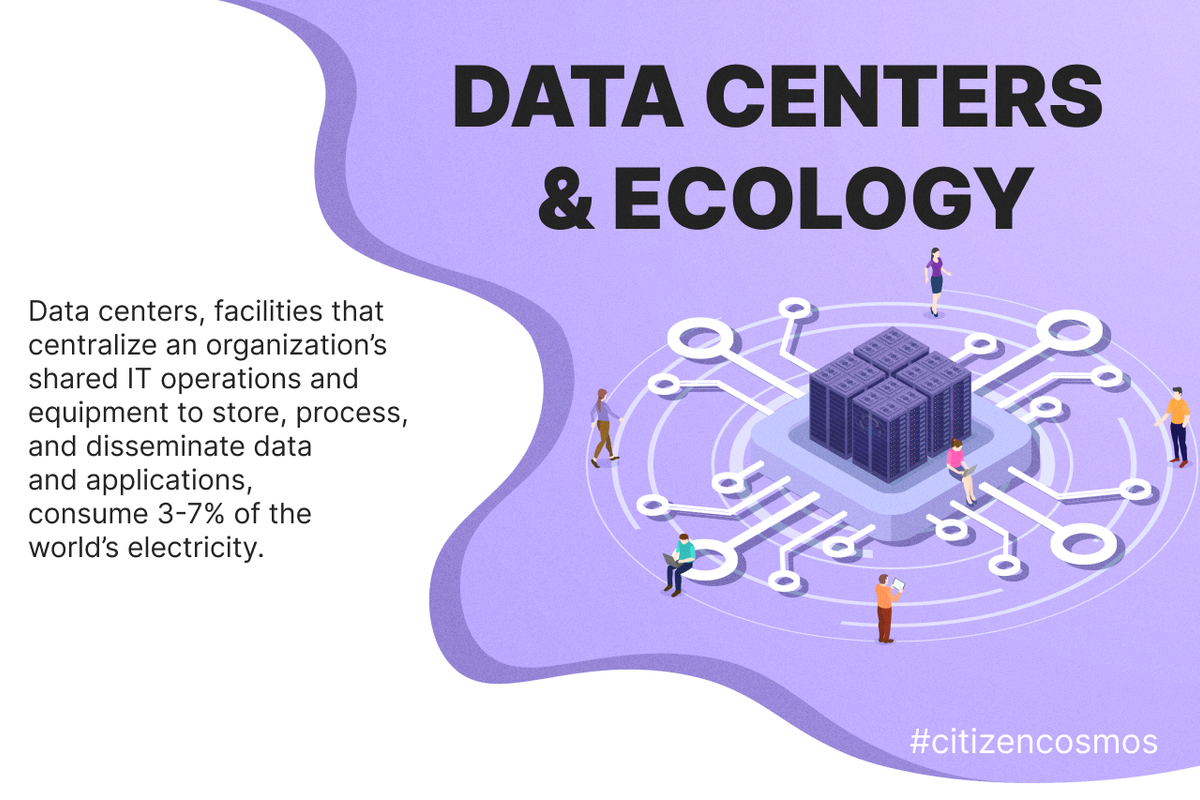Data Centers & Ecology
Data Centers & Ecology
The 66th episode of Citizen Cosmos was dedicated to the CUDOS project - the decentralized cloud computing network. Among the topics discussed with Matt Hawkins, the CEO of CUDOS, were crypto, mining, diversity of cloud computing projects, gaming, education, and many more. However, above all these topics stands the primary goal of CUDOS is sustainability and eco-friendliness. Therefore, we will discuss the data centers, their harmful impact on the ecology, and the ways of dealing with them.
Data centers, facilities that centralize an organization's shared IT operations and equipment to store, process, and disseminate data and applications, consume 3-7% of the world's electricity. In addition, data centers require 24/7 to keep their equipment running. As a result, the operation of the data center provokes greenhouse gas emissions into the atmosphere. CO2 emissions are also results of data centers usage of computing power making it one of the most disturbing factors. Moreover, this does not even consider the impact of construction of the data center, which is also the sourse of various harmful emissions. To learn more about the carbon footprint the data centers and cloud computing leave, we recommend reading Hessam Lavi's article from Climatiq.
PUE
As the problem of data centers’ harmful emissions is becoming more and more disturbing, many big and smaller companies are considering the PUE. PUE or Power Utilization Efficiency is a metric for evaluating the energy efficiency of a data center. PUE reflects the electrical energy consumed by the data center to the point consumed directly by the data center equipment. For example, if the data center receives 10 MW of power from the network and all equipment keeps at 5 MW, the PUE indicator will be 2. If the reading gap decreases, the coefficient will be 1, which is perfect. The PUE is globally used to understand which regions are affected mainly by the data centers' emissions. However, although the indicator may help some areas to start working on problem-solving, it might sometimes be unjust. For example, some data centers simply have worse climatic conditions than others. So, to cool a conditional data center in South Africa, you need much more electricity than a data center in Iceland. The most energy inefficient data centers are in Latin America, Africa, the Middle East, and parts of the Asia-Pacific region. Europe and the area uniting the USA and Canada are among the leaders in terms of PUE. So how can the PUE be lowered, especially for the regions with a hot climate?
Free cooling
One of the ways to lower the PUE is free cooling. A significant percentage of energy consumed by data centers goes to operating artificial cooling systems. The implementation of free cooling is one of the ways to reduce the cost of this energy. The outside air is filtered, heated, cooled, and supplied into the server room. Exhaust hot air is thrown out or partially mixed with the incoming flow. The more outdoor air temperature is suitable for the data center hall, the less energy is needed to bring it to the desired condition.
Proper use of the capacity available in the data center can also contribute to energy efficiency. For example, the purchased servers should either work for the clients' tasks or consume minimal energy during downtime. One way to control the situation is to use infrastructure management software. For example, a data center infrastructure management system. This software automatically redistributes the server load, disables idle devices, and recommends the cooling fans' rotation speed. In addition, timely updating of equipment is an integral part of improving the data center's energy efficiency. For example, an outdated server is often inferior in performance and resource intensity to a new generation server. Therefore, to reduce PUE, it is recommended to update the equipment as often as possible.
Finally, the optimal way to lower PUE is to use virtual servers. They consume 80% less energy. It happens because putting more virtual servers on fewer physical machines incurs hardware maintenance, cooling, and power costs. In addition, virtualization allows reallocating virtual resources from processors to storage. Therefore, electricity is only used to ensure operation, and alternative energy sources improve energy efficiency.
Particular actions
Talking about CUDOS and their dedication to sustainability and reduction of carbon footprint, it is important to talk about their particular actions. Cudos offers scalable computing solutions that address two apparent possibilities. Firstly, the Cudos network is an l1 blockchain in the Cosmos ecosystem. It uses a consensus system with delegated share confirmation (DPoS). At its core, PoS is also more careful about the environment. Therefore, it does not require energy for crypto mining, like the Proof of Work protocol. By communicating with other networks and providing data and computing oracles, the Cudos network can also effectively act as an l2 solution for other blockchains and solve scalability and throughput problems. Secondly, Cudo Ventures is working on creating a platform for automating the process of managing and trading unused computing power. Finally, it improves existing cloud service offerings regarding supply and demand for computing power. Thus, the Cudo solution will provide sustainability, economic rewards, and improved and personalized services. Ultimately, Cudo aims to connect them by giving them the first ever new Level 3. Furthermore, it will allow blockchain networks to seamlessly perform any computing work, integrating cloud and blockchain solutions into one.
Today, data centers are one of the most worrying sources of ecological problems. However, more and more companies are striving to make the data-keeping process as eco-friendly as possible regarding the PUE index. As we see even smaller companies like CUDOS getting involved in sustainability awareness, we can be sure that sooner or later, most data centers will be energy efficient.
If you would like to support our mission in creating educational content and aligning the goals of different communities, please stake with us here:
Join our community, to build a future where communication is decentralized. May the code be with you!
